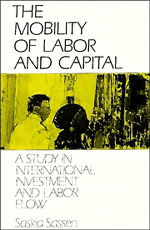Book contents
- Frontmatter
- Contents
- List of tables
- Acknowledgements
- Introduction
- 1 Foreign investment: a neglected variable
- 2 The use of foreign workers
- 3 The new immigration
- 4 The globalization of production: implications for labor migration
- 5 The rise of global cities and the new labor demand
- 6 The reconcentration of capital in the United States: a new investment zone?
- Conclusion
- Notes
- References
- Index
6 - The reconcentration of capital in the United States: a new investment zone?
Published online by Cambridge University Press: 04 April 2011
- Frontmatter
- Contents
- List of tables
- Acknowledgements
- Introduction
- 1 Foreign investment: a neglected variable
- 2 The use of foreign workers
- 3 The new immigration
- 4 The globalization of production: implications for labor migration
- 5 The rise of global cities and the new labor demand
- 6 The reconcentration of capital in the United States: a new investment zone?
- Conclusion
- Notes
- References
- Index
Summary
There is today a global marketplace of production sites. The decade of the 1970s saw the massive and rapid development of such production sites in select areas of South-East Asia and the Caribbean Basin. And towards the late 1970s cities such as New York and Los Angeles emerge as major locations for the placement of international financial investments and for the production of specialized services for the world market. To these two developments I would add a third pattern, becoming evident in the 1980s: the possibility that several regions in highly industrialized countries are becoming competitive with industrial zones in the Third World as locations for direct investment, both foreign and national. Reasons for this can be found in new locational constraints due to technological requirements, protectionist policies, notably in the United States, and rising political and economic costs of production in Third World export manufacturing zones. These changes involve mostly the United States. Technical, economic, and political constraints along with changes in the territorial organization of production and the availability of a low-wage immigrant work force make certain regions in the U.S. internationally competitive and thus part of the global marketplace of production sites. Some of the less industrialized countries in the developed world, such as Spain and Ireland, are also emerging as investment zones for world capital.
- Type
- Chapter
- Information
- The Mobility of Labor and CapitalA Study in International Investment and Labor Flow, pp. 171 - 185Publisher: Cambridge University PressPrint publication year: 1988



